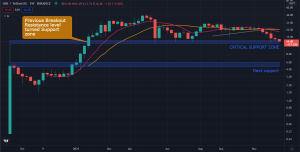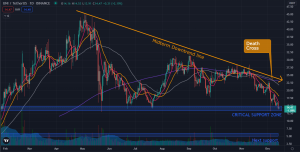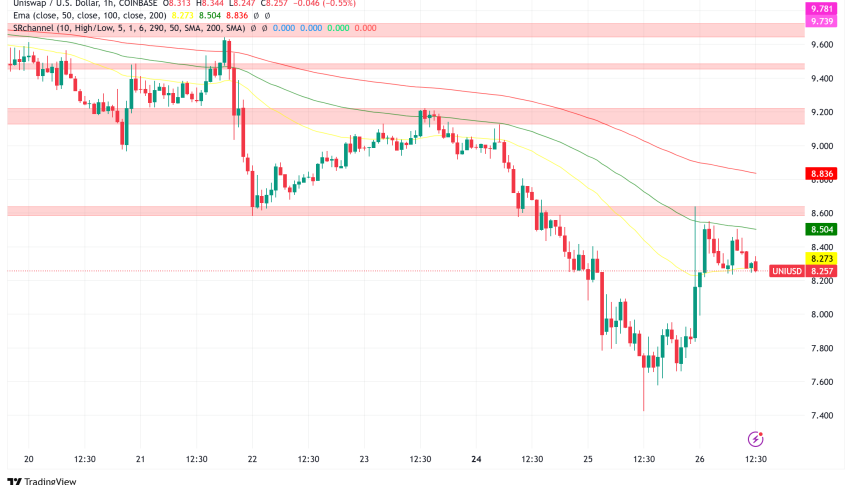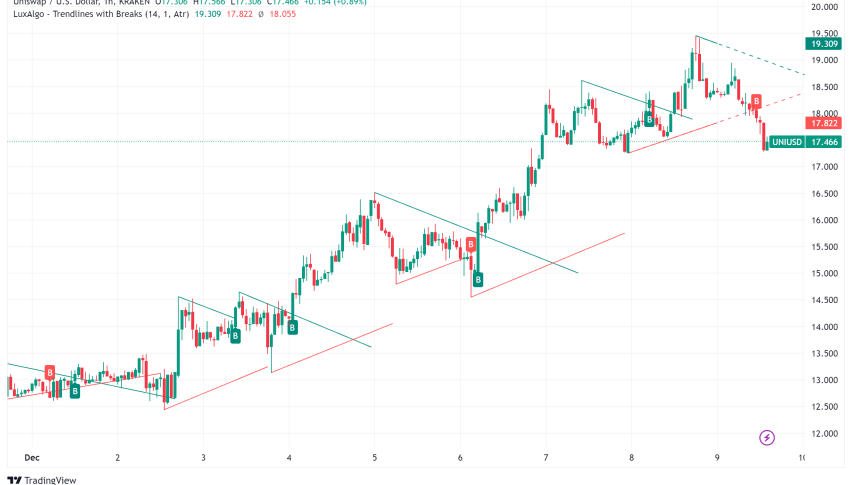UNI/USD – Forecast Summary
| UNI/USD Forecast: H1 2022 Price: $8-24 Price drivers: US Fed Tapering, Rising Inflation, Regulatory risks, Weak Market Sentiment | UNI/USD Forecast: 1 Year Price: $25 – 45 Price drivers: Product Adoption, Market Recovery | UNI/USD Forecast: 3 Years Price: $50+ Price drivers: Cryptocurrency Adoption, Overall Market Environment, UniSwap Innovations |
UniSwap began 2021 with a blistering run, to create new all-time highs, as it rallied above the previous resistance of $15.00. It continued this amazing run to reach a top of $45 last May 2021. Then all of a sudden, in the same month, it all came crashing down, along with the entire cryptocurrency market. UNI/USD fell to a low of $13.00 within a span of three weeks – a devastating 70% loss from all-time highs – before rebounding.
In the same period, major cryptocurrencies all followed suit, dropping hard before consolidating. Bitcoin (BTC) lost 50% of its value (from $52,900 down to $30,000) and Ethereum (ETH) fell 60% (from $4,372 down to $1,728), along with most other altcoins, like Solana, Cardano and Ripple.
Since the crypto-crash of May, UniSwap has been trading within a range, between the major support of $13.00 and the psychological resistance level of $30.00, creating a midterm downtrend line, with an evident bearish bias, as the bears continue to sell down the price.
The overall weakness in the financial markets is due to various macroeconomic factors, such as tapering by the US Fed, rising global inflation rates, more crypto regulation and new COVID-19 variants. Investors and traders have decided to take money off the table and keep their profits, as the overall environment becomes riskier. Money outflow has been evident in almost all risky financial markets – bonds, equities and cryptocurrency. And with the cryptocurrency market being the most volatile, this is where capital flows out from first.
Recent Changes in the UNI/USD Price
| Period | Price | Change ($) | Change % |
| 1 Month | 24.570 | -10.07 | -41% |
| 2 Months | 25.900 | -11.40 | -44% |
| 3 Months | 27.470 | -12.97 | -47% |
| 6 Year | 22.180 | -7.68 | -35% |
| 1 Year | 3.480 | 11.02 | 317% |
UNI Live Chart
UniSwap was created by Hayden Adams, a former engineer at Siemens, in November 2018. It was built on the Ethereum network and was created to facilitate easier and faster trading of various cryptocurrencies. UniSwap is essentially a decentralized exchange (DEX) which is an alternative to centralized exchanges.
UniSwap is also what we call an automated market maker (AMM), which uses smart contracts and liquidity pools to facilitate transactions with lower spreads than the traditional order book method of slow and inefficient matching of willing buyers and sellers. All of these processes and transactions are automated under the UniSwap factory smart contract. UniSwap creates the market through the smart contracts algorithm.
All transactions are automated and decentralized via the smart contract, without any human intervention, which makes it faster, easier and more cost-effective. UniSwap allows any user to perform transactions on their platform, without the need to submit a KYC application.
This is not to say that there are no risks when using DEX protocols like UniSwap. The main problem with DEXs is their reliance on the open-source, smart contracts algorithm. If there is a bug in the code of the smart contract, any smart hacker can exploit this and take your money. Since everything is automated, another problem crops up if you transact using AMMs; as there is no human intervention, if you enter the wrong wallet address or make a mistake in the transaction process, there is no customer support to help you out. You will lose your money, even if you make a mistake with just one letter or one digit of your wallet address.
UniSwap’s native token is the “UNI”, which gives holders governance or voting rights with regard to changes in the protocol. UniSwap is currently the 19th-largest cryptocurrency overall, with a market cap of $9.311 billion. Based on coinmarketcap.com figures, it has a circulating supply of 627,936,759 UNI coins, and a maximum supply of 1,000,000,000 UNI coins. It is the fourth-largest DeFi token, behind Terra (LUNA), Avalanche (AVAX) and Wrapped Bitcoin (WBTC).
UniSwap Price Prediction for the Next 3 Years
UNI/USD Factors Affecting the Price
The great thing about UniSwap is the constant striving for improvements to its platform. It launched UniSwap V2 in 2018, providing new features, such as price oracles, flash swaps and more ERC-20 pairs.
Fast forward to May 2021: Uniswap V3 was released to the mainnet, driving UNI/USD to a new all-time high of $45.00. According to their white paper, the new version makes several architectural improvements, namely concentrated liquidity, flexible fees, protocol fee governance, improved price oracle and liquidity oracle. It would be interesting to see what the UniSwap team conjures up next for UniSwap V4 in the future.
UniSwap has also consistently supported new projects and listed new coins. One such project is Polygen (PGEN) which is a community launchpad that allows smaller teams to experiment, innovate and launch their own cryptocurrency projects. As long as the innovation pipeline is continuous, UniSwap should progress continuously into the future.
A key price driver for UniSwap is its popularity and marketability. Its sleek, user-friendly platform helped build its current community of users. Marketing is a key component when it comes to getting more and more new users to use the DEX. If you go to their website, Uniswap.org, you will see continuous changes and upgrades to their branding and logo. They understand that popularity is a key driver in acquiring new users for their platform.
However, external competitor risks have also emerged, as other DEXs and AMMs have entered the space. Exchanges, such as PancakeSwap (CAKE), SushiSwap (SUSHI), BurgerSwap (BURGER), TraderJoe and 1inch, could threaten UniSwap’s ranking in the marketplace. It is critical to them to constantly innovate and improve their services, in order to keep up with the fast competition and the ever-changing market.
General Market Environment Risks and Capital Outflows
Lastly, it is important to understand the general market environment, as a whole, with regard to where the money may be flowing in the next few years.
The US Fed’s inclination to speed up tapering would severely hit capital inflows into the cryptocurrency market. As financial institutions tighten, with investors and traders looking for safer havens, liquidity may soon dry up the cryptocurrency market, as it is the most volatile of all the major financial markets. Quantitative easing and the COVID stimulus are most likely to have been the major reason why the cryptocurrency market rallied as fast as it did in 2020/2021, but now that these two have gone, where will the money that would bring cryptocurrencies back to all-time highs come from?
Further downsides may emerge, such as more regulatory risks and banning of cryptocurrencies by various governments. Many from the cryptocurrency communities dislike regulations, due to them being too restrictive and controlling, which neutralizes the very essence of decentralization, while governments dislike cryptocurrencies for exactly that reason – with some countries, like China, banning them outright. Without a balanced compromise, the rise to new ATHs in the cryptocurrency market could be a tough one, as we are currently seeing.
Ethereum (ETH) Price Prediction For 2022: The $5,000 Level is the Next Target
Bitcoin (BTC) Price Prediction For 2022: BTC/USD Targeting $100,000
UNI/USD Technical Analysis: Hanging at a Critical Support Zone

*Weekly Timeframe: UNI revisits a critical support area for the 5th time this year
UNI/USD could go lower if it breaches the support area of $13-14. As seen on the weekly chart above, this area was a previous resistance level that was broken out of in early 2021, when the price reached new all-time highs of $45, before crashing back down again, to the same level.
The previous resistance has now turned into a major support zone for UNI/USD, as the bulls have exhibited buying demand every time the bears have tried to sell down below it, proving that a lot of traders and institutional investors are indeed eyeing this level as a key area to buy the dip. If history repeats itself and the price holds above this level and rebounds again, this could be a buying opportunity for retail investors.

However, UNI/USD has lots of headwind if you look deeper into the daily timeframe. It has now formed a midterm downtrend line that began when it reached all-time highs of $45, crashing to $13 in the same month. Since then, UNI/USD has had a tough time rallying back to previous highs.
Moreover, a bearish “Death Cross” has just appeared, as the 50-day moving average (gray line) has now crossed below the longer-term 200-day moving average (purple line). Most technical analysts use this as a gauge of the overall health of a financial asset. A “Death Cross” usually signals more pain ahead, as more selling pressure comes into the market. If it does not rebound in the short term, we could see UNI/USD reaching a price as low as $5.00, which is the next support level.




